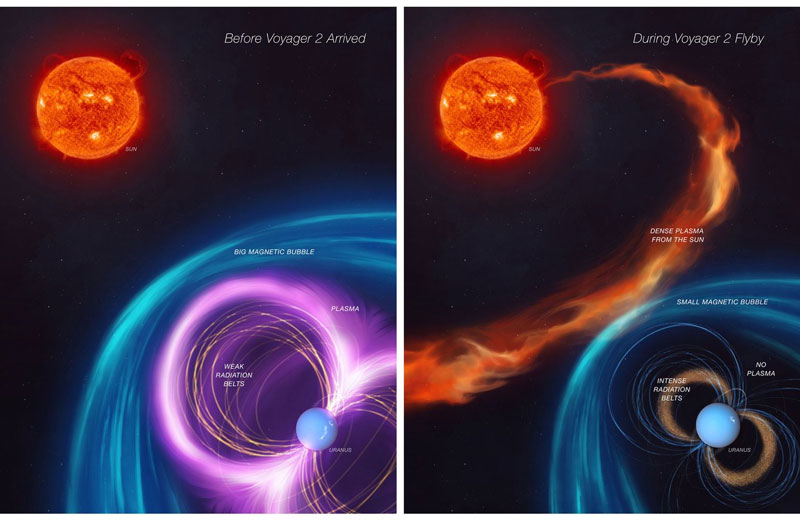Voyager 2 data from 38 years ago found the answer to one of the long-standing mysteries of Uranus.


In 1986, NASA’s Voyager 2 probe flew past Uranus, the distant seventh planet in the solar system. During the flyby, he took a picture of the planet’s magnetosphere, the decoding of which puzzled scientists. The configuration of Uranus’s magnetosphere turned out to be so unexpected that there was no clear scientific explanation for it. A new study of Voyager 2 archival data has helped us understand this puzzle.


On the left is the normal state of the magnetosphere of Uranus, on the right is under the influence of the solar wind. Image source: NASA
The magnetosphere of planets protects them from the flow of cosmic particles and solar particles – plasma or solar wind. This, in particular, leads to the formation of weak radiation belts around the planets, in which high-energy particles accumulate, like in virtual donuts. This belt around the Earth is called the Van Allen Belt. From the data obtained 38 years ago by Voyager 2, it followed that Uranus has a highly compressed magnetosphere, devoid of plasma, and a powerful radiation belt, which in terms of radiation intensity was second only to the belts of Jupiter. This simply could not happen.
A new study of the probe’s archival data has finally revealed the reason for this discrepancy. It turned out that it was a rare coincidence of circumstances. The magnetosphere of Uranus is in the state recorded by the probe only about 4% of the time, and Voyager 2 was lucky (or unlucky) to fly past the planet during this rare period of time. The rest of the time, the magnetosphere of Uranus is “normal”, and its dynamics are not much different from the dynamics of the magnetosphere, for example, of the Earth.
Uranium in natural colors. 1986 image from Voyager 2
A few days before the flyby of Uranus, the planet was exposed to massive solar wind. Solar plasma greatly compressed Uranus’ magnetosphere and radiation belts, and also displaced local plasma – water ions emitted by the planet’s moons. By the way, the lack of data on local plasma in the Voyager 2 records led scientists to assume that all five of the nearest moons of Uranus are geologically dead. However, now there is an opportunity to refute this statement. The probe simply flew past the planet at the wrong time. This is good news for planetary scientists – the Uranian system, as it turns out, has a lot of interesting things, and the planet is waiting for its discoverers.
Recent Posts
China’s XPeng Releases $20,000 MONA M03 Max Electric Car With Free Autopilot
Chinese company XPeng has unveiled the MONA M03 Max, a car with an AI-powered autonomous…
Sony lifts regional restrictions from Stellar Blade on PC, and a demo version of the game is released on Steam
The developers of the post-apocalyptic action game Stellar Blade from the South Korean studio Shift…
The Slormancer — Diablo Without the Frills. Review
Played on PC Over the last couple of years, the Diabloid subgenre has clearly entered…
Modder Already Added Two-Player Mode to Elden Ring Nightreign That Developers Forgot About
Less than a day has passed since the release of the cooperative roguelike action game…
Microsoft delays development of portable Xbox, will focus on partner consoles
According to Windows Central, Microsoft has postponed development of its own portable gaming console with…
A demo of Dispatch, a comedy game about a superhero agency from the former developers of Tales from the Borderlands and The Wolf Among Us, has been released on Steam
Developers from the American AdHoc Studio, founded by former Telltale Games, Ubisoft and Night School…